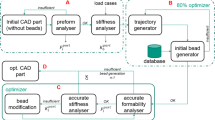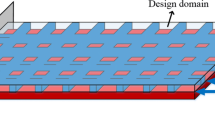Abstract
Introducing beads into thin-walled structures for enhancing bending stiffness is a common practice and has been used for many decades. Typically, forms and patterns of such beads are rather based on experience as well as practical results than on analytical or numerical investigations. Recently computational methods have been developed for designing or optimizing beads. The paper at hand contributes to these attempts. It deals with increasing the buckling resistance as well as the fundamental frequency of thin-walled structures by systematic bead design. The design strategy is based on the idea to disturb the buckling mode and the fundamental vibration mode, respectively, of a structure in an efficient way by laying beads along the direction of the occurring maximum principal curvature of the corresponding mode shape. Since the beads influence this mode shape, an incremental approach is required. Numerical investigations into plate and profile structures are performed by applying this new iterative design procedure in combination with the finite element method.
Similar content being viewed by others
References
Amabili M.: Nonlinear Vibrations and Stability of Shells and Plates. Cambridge University Press, New York (2008)
Singer J., Arbocz J., Weller T.: Buckling Experiments, vol. 1. Wiley, New York (1998)
Rammerstorfer F.G., Beer R.: Die Erhöhung der Grundfrequenz und der Beullast von Kreisplatten durch geeignete plastische Verformung. Forsch. Ing.-Wes. 42, 168–172 (1976)
Rammerstorfer F.G.: Increase of the first natural frequency and buckling load of plates by optimal fields of initial stresses. Acta Mech. 27, 217–238 (1977)
Bilik C., Rammerstorfer F.G., Figala G., Buchmayr B.: Computational modeling of laser treatment of plates for increased buckling loads and natural frequencies. J. Mech. Eng. Sci. 225, 2385–2398 (2011)
Schwarz D.: Auslegung von Blechen mit Sicken-Sickenatlas, FAT-Schriftenreihe Nr. 168. VDA, Frankfurt (2002)
Hyper Works 8.0, Optistruct 8.0, Altair Engineering, Troy, Michigan, USA (2007)
Emmrich, D.: Entwicklung einer FEM-basierten Methode zur Gestaltung von Sicken für biegebeanspruchte Leitstützstrukturen im Konstruktionsprozess. Dissertation, Institut für Produktentwicklung, Universität Karlsruhe (2005)
Luo J.H., Gea H.C.: Optimal bead orientation of 3D shell/plate structures. Finite Elem. Anal. Des. 31, 55–71 (1998)
Wang J.: Design optimization of rigid metal containers. Finite Elem. Anal. Des. 37, 273–286 (2001)
Daoud, F.: Formoptimierung von Freiformschalen-Mathematische Algorithmen und Filtertechniken. Dissertation, Technische Universität München (2005)
Rammerstorfer F.G.: Leichtbau-Repetitorium. R. Oldenbourg Verlag, Wien-München (1992)
Author information
Authors and Affiliations
Corresponding author
Additional information
Dedicated to Professor Hans Irschik on the occasion of his 60th birthday.
Rights and permissions
About this article
Cite this article
Bilik, C., Pahr, D.H. & Rammerstorfer, F.G. A bead laying algorithm for enhancing the stability and dynamic behavior of thin-walled structures. Acta Mech 223, 1621–1631 (2012). https://doi.org/10.1007/s00707-012-0645-9
Received:
Revised:
Published:
Issue Date:
DOI: https://doi.org/10.1007/s00707-012-0645-9




